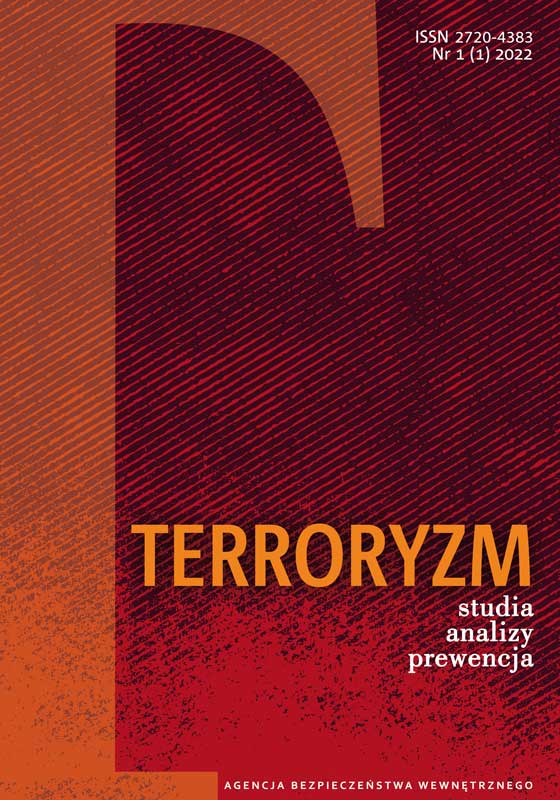Problematyka ochrony antyterrorystycznej miejsc kultu religijnego
Anti-terrorist protection of places of worship
Author(s): Artur SybickiSubject(s): Politics, Security and defense
Published by: Wydawnictwo Uniwersytetu Jagiellońskiego
Keywords: religious facilities; places of worship; anti-terrorist protection system for religious facilities; terrorist safety of places of worship
Summary/Abstract: Ataki terrorystyczne w Europie na obiekty sakralne wymusiły w polityce bezpieczeństwa państw członkowskich UE, na których terenie do nich doszło, opracowanie i wdrożenie rozwiązań (prawnych, merytorycznych, technicznych i fizycznych) proporcjonalnych do charakteru i rodzaju danego obiektu. Celem ich wprowadzenia jest wzmocnienie poziomu ochrony antyterrorystycznej zarówno samego miejsca kultu religijnego, jak i osób mających z nim bezpośredni kontakt (duchownych oraz uczestników zgromadzeń liturgicznych). Czynniki świadczące o atrakcyjności obiektów sakralnych jako celów zamachów terrorystycznych, w tym główne zagrożenia ich bezpieczeństwa, oraz wymagane elementy systemu ich ochrony antyterrorystycznej w wielu państwach pozostają tożsame. Istotnym zagadnieniem jest również to, że polskie miejsca kultu religijnego mają wiele cech, które umiejscawiają je w gronie obiektów użyteczności publicznej zagrożonych ewentualnymi zdarzeniami o charakterze terrorystycznym. Można odnieść jednak wrażenie, że kwestie dotyczące ich ochrony antyterrorystycznej nie są traktowane na terytorium RP systemowo. Dużo dyskutuje się na temat bezpieczeństwa obiektów użyteczności publicznej, jednak polscy naukowcy i eksperci praktycy w zakresie bezpieczeństwa terrorystycznego nie skupili na nich swojej uwagi w sposób kompleksowy. Przełomowy w opracowaniu i budowaniu systemów bezpieczeństwa antyterrorystycznego miejsc kultu, zarówno w wymiarze europejskim, jak i polskim, jest rok 2021. Komisja Europejska finansuje bowiem w tym zakresie sześć projektów (jeden pod przewodnictwem Uniwersytetu Łódzkiego jest realizowany na terytorium RP), których celem jest usystematyzowanie problematyki ochrony antyterrorystycznej obiektów sakralnych, a w przyszłości zwiększenie poziomu ich ochrony przed niebezpieczeństwami. Intencją autora artykułu jest przedstawienie rozwiązań w tym zakresie procedowanych przez Komisję Europejską i uzyskanie odpowiedzi na pytanie, w jakim stopniu polskie obiekty sakralne są przygotowane na niebezpieczne incydenty, zwłaszcza te o charakterze terrorystycznym. [Terrorist attacks in Europe, which targeted religious sites, forced the security policy of the EU Member States on whose territory they occurred to develop and implement solutions (legal, substantive, technical and physical) proportionate to the nature and type of the facility inquestion. The purpose of their introduction is to strengthen the level of anti-terrorist protection both for the religious site itself and for those in direct contact withit (clergy and participants in liturgical gatherings). The factors proving the attractiveness of religious sites as targets for terrorist attacks, including the main threats to their security, and the required elements of their anti-terrorist protection system remain the same in many countries. It is also important to note that Polish places of religious worship have many characteristics that place them among the public facilities at risk of possible terrorist incidents. However, one can get the impression that the issues concerning their anti-terrorist protection are not treated systematically on the territory of the Republic of Poland. There is a lot of discussion about the security of public facilities, but Polish researchers and practitioner experts in the field of terrorist security have not focused their attention on them in a comprehensive way. A breakthrough in the development and construction of antiterrorist security systems for places of worship, both in the European and Polish dimensions, is the year 2021, because the European Commission finances six projects in this area (one under the leadership of the University of Lodz, implemented in the territory of Poland), which aim to systematize the problems of anti-terrorist protection of religious facilities, and in the future to increase the level of their protection against dangers. The intention of the author of this article is to present solutions in this field, which are being prepared by the European Commission, and to obtain an answer to the question, to what extent Polish religious facilities are prepared for dangerous incidents, especially those of a terrorist nature.]
Journal: Terroryzm. Studia, analizy, prewencja
- Issue Year: 2022
- Issue No: 1 (1)
- Page Range: 200-227
- Page Count: 28
- Language: Polish

